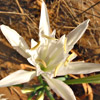The sea daffodil blooms magnificently in the months of August, September. Some years it may start as early as July and in others end in October. This plant is what the botanist call ‘a geophyte’, a plant that has a perennial bulb. The bulb produces off-springs that usually form a large clone. The leaves are linear, narrow and elongated. They have a waxy, water repellent, coating that protects them from the salty sea-spray which gives them a bluish tint. The leafless stalk is erect, green and may reach 60 cm. It bears a group of up to a dozen large white flowers at the top. The large, white flowers are 13 cm. in length, produce large amounts of nectar and give off a strong sweet smell.
The Hebrew name is mentioned in the Songs of Solomon (2:1) as “rose of Sharon”. Indeed, in Israel it grows in the Sharon, along the coast of the Mediterranean. The funnel like corolla is made of six petals that unite to from a long tube at their base, and six narrow lobes surround the opening. As the outer side each petal has a narrow green stripe. Inside the corolla the wide filaments of the stamens merge to form an inner conspicuous white crown that adds a lot to the beauty and attraction of the flower. The long pistil has three lobed stigma. As in other members of the Amaryllidaceae, the inferior ovary looks like a green bulge at the top of the pedicel.
The flowers open at dusk and wilt by the next noon. They are pollinated by moths which are active in the evening. The strong coastal breeze during the day usually prevent any insect activity during the day. The fruits are oval with three facets and contain about 20 seeds each embedded I a thick, black spongy, water repellent layer. This layer allows the seeds to float in the seawater without being spoiled.
The sea daffodils grown no more than 100 m from the coast on sandy or loamy soils or calcareous stones. This plant is protected by law and must not be picked or uprooted. It appears along all the coasts of the Mediterranean from Israel in the East to Spain in the West.
In folklore medicine its bulb was used to treat runny noses and to strengthen the heart.
The genus includes 15 species 3 of which grow in Israel.
Written by Mike Livne





